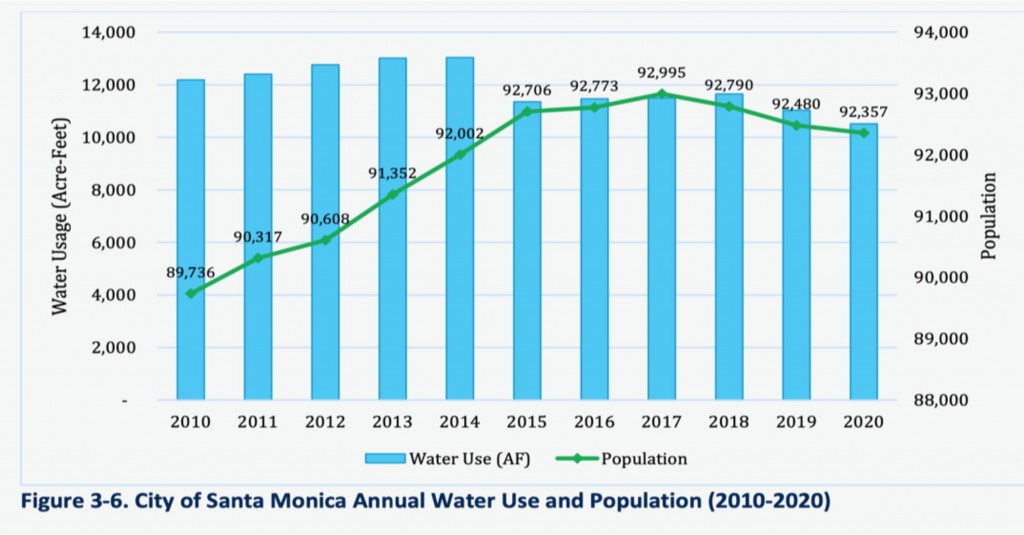
What happens when a City runs out of water? You have already heard of the torture endured by communities in the Central Valley that ran out of water, but we already have had a recent example of a nearby wealthy California coastal community that ran out of water. In 2014, under a punishing drought, the 14,000 residents of Montecito simply ran out of water. Their local wells and reservoirs were running dry and since they didn’t have access to the equally stressed California aqueduct system, they were facing catastrophc failure. They ordered water rationing, a draconian 30% cut in water use enforced by fines, stopped issuing building permits, and banned new pools and spas or refilling existing ones with City water. This is where the story gets instructive for Santa Monica.
Montecito residents responded appropriately with an astounding 48% water reduction as lawns turned yellow, swimming pools evaporated and $4 million in fines was collected from scofflaws with 400 shut off notices sent to the repeat offenders. Residents showered at the Y and took their laundry to the public laundromats and essentially let their beloved landscaping go. Oprah cut her $125,000 annual water bill in half by using her own wells, conservation and trucking in water.(see Politico Magazine 8/24/14).

Deviant Behaviors Emerged
But deviant behaviors also emerged. As soon as the building freeze went into effect, a black market developed in water permits as owners of under developed parcels sold their water rights. This left certain properties unbuildable since they had sold off their water access.
Likewise wealthier residents started paying tanker trucks to import water at usurious prices and residents started drilling their own wells further lowering their own city’s endangered water table. Some of the tanker trucks were found to be stealing water from fire hydrants, lakes and adjacent cities creating in effect a water war fueled by the wealth of this unique city. Finally 5-10% of the users chose to pay the fines rather then meet the rationing targets. In Santa Monica’s somewhat parallel case, when given a choice of complying with our Water Neutrality Plan (you can’t use more water on a new project than was being used originally on that site), about 75% of the developers opt to pay the additional fee rather than trying to stick to the constraints of the site’s original water consumption.
Naturally Montecito’s situation was unstable and unsustainable but fortunately the city managed to stagger through. The needed scapegoat was found and in 2016-2018 the local water board was all voted out of office and replaced with a new board that in 2020 inked a deal to buy 1430 acre feet (AF) or 40% of Montecito’s need, from Santa Barbara’s desalinization plant. As a point of comparison Santa Monica’s 2020 water usage is about 10,500 AF or 7 times Montecito’s desalinized water. That plant had been mothballed because it was too expensive to run, is now being reactivated and Montecito’s costly deal will run for half a century from 2022 to 2072. The plant cost $72M to build and Montecito will pay $33M (46%) or initially $2894 a year for each of the typical 11,400 accounts triggering an initial 20% water rate increase.
A Faustian Bargain
In short, a wealthy city can try to buy its way out of a water crisis, if it has a neighboring City that has already done the heavy investment of a desalinization plant. However, notice that desalinization is not “free”. It typically costs about twice the cost of ground and surface water, uses incredible amounts of energy (and space if the energy is from adjacent photo-voltaics), and alters the biology of local waters by sucking in all kinds of small marine life and excreting a toxic briny exhaust. Desalinization is a Faustian bargain because of its substantial financial and environmental costs.
Here in Santa Monica, we face a similar zero-sum water game as shown in the City’s 2021 Urban Water master plan. In 2025 Santa Monica’s available water sources are optimistically projected to be:
10,650 AF – Ground Water wells
7,406 AF – Imported water from the Metropolitan Water District (MWD)
560 AF – Recycled stormwater/ brackish water
18,626 AF – Seemingly comfortable total
However, there are multiple risks challenging this rosy scenario:
- Santa Monica’s Planners typically use a 5-year horizon to assess sufficiency The mantra we hear is that under existing conditions, we have no problem. But, as global warming is a long term, almost geologic trend, five years is a barely measurable beginning. Moreover, the community lives with the impact of development for decades. Thus, long term supply and demand problems are managed with an extremely short term view.
- Increasing demand from the RHNA-driven 17,800 population (19%) spike. Sacramento’s unsustainable demand that Santa Monica permit 8,895 new units by 2029 (see chart above how population and water use are closely linked) . The projected rise of water usage in 2030 will balloon up to about 13,442 AF. This is already about 6.8% more than is available from our wells (5181 AF) plus MWD (7406AF) during a typical drought year (12,587 AF). We were promised water neutrality by 2020, then by 2023 and but now Sacramento has made that a hopeless mirage. This is our first red warning light.
- Can’t we just pump more water? Possibly yes, since our total basin capacity is probably still underutilized, but unfortunately our actual well production will continue to decrease, so we will need to drill new wells and filter more efficiently. The unknown is at what point is our basin drained faster than it can recharge? Our total available ground water basin projections, are just that, an informed guess. Basin capacity is an inexact science: while the previous maximum range was 15,290 AF-19,700 AF, now the new sustainable basin limits are estimated at 11,800 AF-14,725 AF (which also assumes we will still have enough extra storm or gray water to keep injecting to recharge our aquifer). Notice this maximum is just barely 9.5% above the 13,442 AF projected for 2030 but the minimum is 12% below. This tiny margin means we cannot realistically achieve water independence with our wells alone and will always be dependent on MWD backup. This is flashing red light #2
- But MWD is not a long-term stable supplier of water. Projections are that the Colorado River water supply, which MWD relies on, is expected to be cut in half in the next few decades. The exact rate of decay of that water source, depends on how fast global warming desiccates its seven state watershed. If Santa Monica’s MWD supplies were cut in half during a drought year, we would expect to be at 8,884AF (5,181AF wells +3,703 MWD) or 34% below our nominal 2030 13,442 AF demand. This would require Montecito style rationing and heroics with the attendant citizen revolt. Flashing light #3.
- Here Comes the Competition. Everything is influenced by global warming and regionally the 3 other cities (Beverly Hills Culver City and Los Angeles City) plus LA County all share our ground water basin. As MWD falters they will want our “cheap water” and nothing can stop them from drilling and purifying the same way we do. Our neighbor will become our competitor. In short, we will have our own water war on our hands just like Montecito. This will increase the drawdown of our water table to possibly below rechargeable levels not to mention the possibility of salt water intrusion from the ocean. Now our entire dashboard is lit up.
Because we have so many visible water danger signs, and so little prudent margin for error, we need to slow down building, conserve more and find more sources of water. Ideally all three should be under consideration. If we don’t, nature will simply shut us down: she is tired of our ignoring her repeated warnings. Notice that Santa Monicans use over a 100 gallons/day while Australians (a very water conscious nation) use about 85 gallons per day. So the City’s conservation programs have some margin for improvement, but its limited. In other words, we will not be able to conserve our way to sustainability: already today we need new sources of water.
There are two obvious sources of water. First partially treated sewer water can be used in dual piped buildings and parts of the City where there is a grey water system in place to feed landscaping, parks etc. The City is already doing this by building the SWIP (Sustainable Water Infrastructure Project) next door to the courthouse. That is essentially a sewer and storm water interceptor and partial treatment plant that should generate some margin of safety and buy us slightly more time to tackle the bigger supply problem. Second, sea water could be desalinated with improved technology (the Santa Barbara desal plant is 30 years old) to reduce its ecological costs. This would require several acres of land and could be built solely or jointly with other cities.
Finally there is some debate as to which is most effective, cost and ecology wise, a sewer treatment plant that purifies to drinking standards or a desalination plant that does the same? All options need to be investigated as our water rapidly vanishes. But all scenarios involve the allocation of land (in the right location) and money, lots of it. Already our water bills will double in the next 5 years. Because any of these options take time to develop, finance and build, and because we face the trauma of a Montecito situation in the immediate future, probably within the next decade, we need to make these important decisions today:
In a fully built-out city, where do you want to put the desalinization plant?
By Mario Fonda-Bonardi for S.M.a.r.t Santa Monica Architects for a Responsible Tomorrow
Thane Roberts, Architect, Robert H. Taylor AIA, Ron Goldman FAIA, Architect, Dan Jansenson, Architect, Building and Fire-Life Safety Commission, Samuel Tolkin Architect, Mario Fonda-Bonardi, AIA, Planning Commissioner,
Marc Verville M.B.A, CPA (Inactive), Michael Jolly, AIR-CRE.
For previous articles see www.santamonicaarch.wordpress.com/writing























